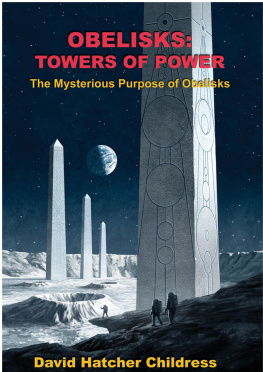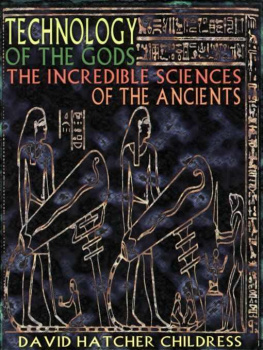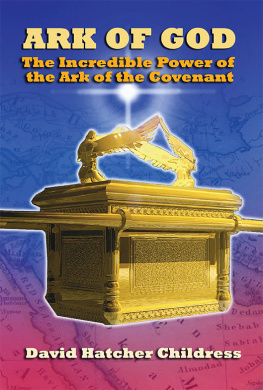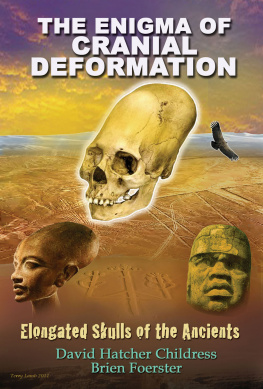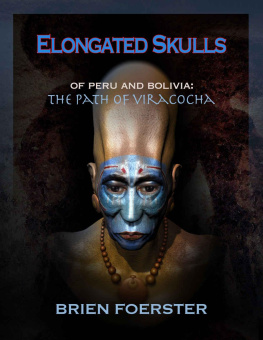
THE ENIGMA
OF CRANIAL
DEFORMATION
Elongated Skulls
ofthe Ancients
David Hatcher Childress
&
Brien Foerster
Other Books by David Hatcher Childress:
THE MYSTERY OF THE OLMECS PIRATES AND THE LOST TEMPLAR FLEET TECHNOLOGY OF THE GODS
A HITCHHIKERS GUIDE TO ARMAGEDDON LOST CONTINENTS & THE HOLLOW EARTH ATLANTIS & THE POWER SYSTEM OF THE GODS THE FANTASTIC INVENTIONS OF NIKOLA TESLA LOST CITIES OF NORTH & CENTRAL AMERICA LOST CITIES OF CHINA, CENTRAL ASIA & INDIA
LOST CITIES & ANCIENT MYSTERIES OF AFRICA & ARABIA LOST CITIES & ANCIENT MYSTERIES OF SOUTH AMERICA LOST CITIES OF ANCIENT LEMURIA & THE PACIFIC
LOST CITIES OF ATLANTIS, ANCIENT EUROPE & THE MEDITERRANEAN LOST CITIES & ANCIENT MYSTERIES OF THE SOUTHWEST
Other Books by Brien Foerster:
A BRIEF HISTORY OF THE INCAS
MACHU PICCHU VIRTUAL GUIDE & SECRETS REVEALED THE ENIGMA OF TIWANAKU AND PUMA PUNKU GRINGO GUIDE MACHU PICCHU AND CUSCO
INCA BEFORE THE CONQUEST BEYOND MACHU PICCHU:
THE OTHER MEGALITHIC MONUMENTS OF ANCIENT PERU
THE ENIGMA
OF CRANIAL
DEFORMATION
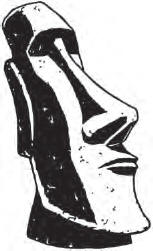
Adventures Unlimited Press
The Enigma of Cranial Deformation
Copyright 2012
by David Hatcher Childress and
Brien Foerster
ISBN 10: 1-935487-76-0
ISBN 13: 978-1-935487-76-0
All Rights Reserved
Published by:
Adventures Unlimited Press
One Adventure Place
Kempton, Illinois 60946 USA
www.adventuresunlimitedpress.com
10 9 8 7 6 5 4 3 2 1
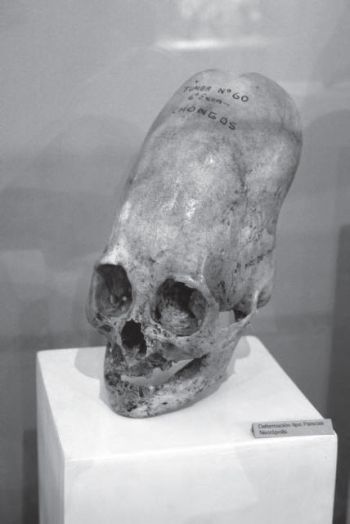
One of the extremely elongated skulls from the Chongos site near Paracas.
Contact David Hatcher Childress at:
www.wexclub.com
Contact Brien Foerster at:
www.HiddenIncaTours.com
For more copies of this book
please go to:
www.adventuresunlimitedpress.com
THE ENIGMA
OF CRANIAL
DEFORMATION
Elongated Skulls
ofthe Ancients
David Hatcher Childress
&
Brien Foerster
CHAPTER 1
MYSTERIOUS ELONGATED SKULLS OF THE ANCIENTS
The human race is over a million years old, But it never seems to act its age.
Professor Hiernonymus
The Mystery of the Strange Coneheads
Many of you may remember the old Saturday Night Live routine with Dan Akroyd and gang as the strange family of Coneheads (later made into a feature movie). This bizarre family of comical weirdos had long, bald heads that were about twice as long as a normal human headheads which came to a sharp point at the top, hence the name coneheads.
As funny and strange as this may appear to television viewers, such coneheads did, and do, exist! In fact, the remains of coneheads of various shapes and sizes have been found all over the world, from Peru and Mexico and the Pacific Northwest to ancient Egypt and China and beyond.
Museums in South America and elsewhere have occasionally exhibited an unusual elongated skull, but they are not particularly common in museums around the world. At the local museums along the southern desert coast of Peru, particularly the anthropological museum in Ica, were a wide variety of elongated skulls and even complete mummies of these people, sometimes with red hair. Similarly, statues with elongated skulls of the Atonists can be seen at the Cairo Archeological Museum. Other museums, in Malta, Turkey, Iraq, Korea, Bolivia, Mexico and elsewhere have skulls with some sort of cranial deformation on exhibit. Many of them, however, are not on display. In some museums, such as the Archeological Museum at Tiwanaku in Bolivia, photography is not allowed (although sneaky tourists have managed to take a few photos).
To the uninitiated, the deformed and extended skulls are rather shocking. They come in all shapes and sizes, some extremely elongated, and some rather squarish, instead of pointed. Just exactly who these people were, why they reshaped heads, and how they created the odd modifications are something of a mystery. The skull elongations are the most prevalent; perhaps we should look into some of the various explanations for these coneheads.
This book will take us to Peru, Bolivia, Egypt, Malta, China and other places in search of strange elongated skulls and other cranial deformation. The puzzle of why diverse ancient peopleeven on remote Pacific Islandswould use headbinding to create elongated heads is mystifying. Where did they even get this idea? Did some people naturally look this waywith long narrow heads? Were they some sort of elite race that roamed the entire planet? Why do anthropologists rarely talk about cranial deformation and know so little about it?

A poster for the 1993 Coneheads movie starring Dan Akroyd.
Types of Cranial Deformation
There are two main types of cranial deformation with a number of sub-types, as we shall see. Mainly skulls are deformed by either being elongated or alternately flattened and made wider. Says the Encyclopedia Britannica:
Modifications of the head have included alterations of the skull, teeth, lips, tongue, nose, or ears. Deformation of the skull is the best-documented form, largely because archaeological skeletal remains clearly show its presence. Tabular deformations are produced by constant pressure of small boards or other flattened surfaces against the infants head (see head flattening). Annular deformations are produced by a constricting band; each kind is subdivided according to the resulting head shape, which is often strikingly different from the unmodified skull. Cases of cranial modification are known from all continents except Australia and Oceania, although it was rather rare in Africa south of the Sahara and apparently absent from South India.
Let us look at information on cranial deformation from the online encyclopedia, Wikipedia:
Artificial cranial deformation, head flattening, or head binding is a form of permanent body alteration in which the skull of a human being is intentionally deformed. It is done by distorting the normal growth of a childs skull by applying force. Flat shapes, elongated ones (produced by binding between two pieces of wood), rounded ones (binding in cloth) and conical ones are among those chosen. It is typically carried out on an infant, as the skull is most pliable at this time. In a typical case, headbinding begins approximately a month after birth and continues for about six months.
Intentionalheadmoldingproducingextreme cranial deformations was once commonly practiced in a number of cultures widely separated geographically and chronologically, and so was probably independently invented more than once. It still occurs today in a few groups, like the Vanuatu. Early examples of intentional human cranial deformation predate written history and date back to 45,000 BC in Neanderthal skulls, and to the Proto- Neolithic Homo sapiens component (12th millennium BC) from Shanidar Cave in Iraq. It occurred among Neolithic peoples in SW Asia.
The earliest written record of cranial deformation dates to 400 BC in Hippocrates description of the Macrocephali or Long-heads, who were named for their practice of cranial modification. The practice was also known among the Australian Aborigines, Maya, and certain tribes of North American natives, most notably the Chinookan tribes of the Northwest and the Choctaw of the Southeast.
Next page



